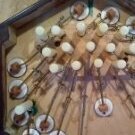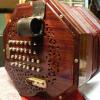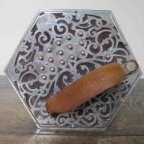Search the Community
Showing results for tags 'chords'.
-
Recently began to work through Gary Coover's excellent starter book for left-hand (LH) harmonic accompaniment on Anglo concertina. Many of the melodies presented in his book are English Country dance tunes, Morris tunes, and original compositions. They can be transcribed into C, Am, F, and Dm which have many LH chord patterns for the 3 or 4 chords required for many tunes. Some more limited chording can also accompany G and even D tunes. The practical requirement is that "most" of the tune be playable on the right hand. Many Irish tunes sit in the middle range of the fiddle, whistle, flute and pipes; low parts of melodies will commonly fall below G or A above middle C and are played with the LH on the Anglo. So, even though it's not traditional, I'd like to see, or work on collecting, a list of Irish tunes of any genre that either fall within the right hand, or can be transcribed into a key that fits there. A subset is tunes that have a second, high or B part that is right hand only. My starter tune: Kesh jig. Except for the tonic G and the A that follows, the tune is all right hand, and notes can be found in the LH for the 3 required chords.
- 11 replies
-
- irish
- harmonicstyle
-
(and 2 more)
Tagged with:
-
Hay everyone, i just bought a Wren from McNeela Music and im hoping that it’ll fulfill my needs. I searched and skavenged the internet for some answers. Maybe you guys can help. I mostly want to back up my singing with the concertina. I come from Ukulele playing and the playing sheets I have are with guitar chords. I’d also like to play some soundtracks from Games and Movies. And I like the style of playing chords an melody at the same time it just sounds more complete to me. I tried to get a Duet at a reasonable price but couldn’t find one for shipping to Germany. Would you guys say if I learn from scratch I’ll be able to do want I want with an Anglo? Or should I try to get a duet for my purposes? thanks for y’all’s advice in advance!
-
Teaching someone to play chords (this includes double stops) and droning on the EC can be overwhelming for some. One way to approach this is to take a fun simple tune, like Blaydon Races, and first learn to play just the melody line. Then slowly add in the double stops, then 3 note chords, and finally the droning. For those who read music I've attached both versions. This is a great session tune and once one plays it with confidence you can begin to add your own touches as well. Blaydon races.pdf BLAYDON Races with chords.pdf
-
Have just bought a copy of Gary Coover's Anglo concertina in the harmonic style to further my understating of chord playing- My concertina is a G/D and the book is written with a C/G in mind. Are there abc notation versions of the tunes as written in the book anywhere, to save me having to create my own abc files to transpose. Or am I missing a trick here?
-
Piggy backing on a recent discussion about playing by ear or playing with dots. One of my intermediate students wants to learn to arrange a tune,primarily using double stops. While she sight reads very well, chord structures are not intuitive to her yet. I recently attended a gypsy jazz session. Most had music or were using an app called iReal Pro that provides chord charts. For me I often need those charts to play and be able to adequately improvise. Many of these tunes use chords in minor, diminished, or modal scales. Chords will often be augmented, have a minor 5th, or add a 6th or 9th. So yes, I often need a chart to follow. But the more I play the easier it becomes to hear the subtle chord changes and automatically play along. Knowing how to employ and play a more complex chord is a skill one needs to develop. A simple double stop is a good way to start. Playing by ear or with music. Why not do both.
-
I am very new to playing the concertina, and am having trouble with the right hand being too quiet when playing an accompanying chord on the left hand. The left hand notes always seem to overpower the right when played in unison. If there is already a conversation about this, I welcome the link. I am trying to figure out if it is a. Human error b. Flaw/damage in instrument c. Both a and b d. Normal. and what I can do to remedy it. Thanks!
- 7 replies
-
- learning
- anglo concertina
-
(and 6 more)
Tagged with:
-
I have a wheatestone C/G anglo with the standard 30-button layout on which I play primarily irish music. I have seen some discussion on modified/hybrid layouts for ITM, but they have all been focused on the mid-range, usually focusing the C#. I am getting fairly comfortable with the wheatstone system in this sense, but there is one thing that has continued to bug me. I would really like to have the D below middle C to throw in chords. As it is I can throw in a nice low G, A or E and even the odd C, but the one I would get the most use out of for irish music woudl be that D. Does anyone have experience modifying the layout in this range? Are there any particular issues one might run into or reason's not to do it. I realize that there could be some issues with differently sized reeds on the low end. Here is the mod that seems the most obvious to me. Remove the low F natural on the pull (top row, far left) and replace that with the low G. (That low F is probably my least used button on the left hand side anyways). Then replace the existing low G pull (Mid row, far left) with a low D pull. It seems like this should be fine space-wise as the G should be the same length or shorter than the F, and the D would be on the same as the low C, so there should be room for it. Plus I think it should only require one new reed since the low-G would just be moved. Moreover this layout seems like it would have nice options for a DA fifth and and an inverted GD fifth on the pull in that leftmost column, As well as a nice D octave combo in the middle row. The lowG-mid D pull that I currently use on the pull would be slightly more awkward, but not prohibatively so. I would love to know if anyone has advice regarding either the ease with which I can find someone who make such a modification (It is beyond my own tinkering ability and comfort) and also if anyone has other alternative layouts for the low range. I am not in any particular hurry, but I do think I will want to do it eventually, maybe once it is in need of a general tuneup. Of course the other option would be down the road to look for a different instrument with more than 30 buttons, but I have a bad habit of acquiring too many instruments as it is. Thank you.
- 10 replies
-
- anglo
- wheatstone
-
(and 8 more)
Tagged with:
-
what i'm asking is it possible to play 2 parts rather than just one eg. a waltz but not within 1 chord eg. C CM CM I like the look of the Anglo however with what i've seen so far on the layout trying to play a polka is a nightmare. or at least say a polka using say a Bb chord and I know about transposing however that being said is it only possible to play chords in 1 range eg. c cm g cm c cm g cm or can you also a other chords and it's limitation being skill. I ask because I don't one but would like to however I like to play two pieces of the song eg. the waltz part or the polka etc. I understand that there is the English concertina however I also understand that it's all quite high pitched and so it wouldn't sound as good that being said I don't own any type of concertina and would like to ask for a suggestion I get that there are the duet systems however they cost alot considering I don't even own a cheap one yet
-
I guess this is one for the ABC experts. As an aid to learning the tunes, I'm transposing some Playford tunes into ABC, and am including chords (these are from another players 'personal' scores). In ABC terms, the tunes are M:C| or M:6/4. The default chord profile for M:C| seems to be %%MIDI gchord fzczfzcz. There doesn't seem to be a default profile for M:6/4 so I have cribbed a profile of %%MIDI gchord fzcfzc from somewhere (*). Both of these profiles produce an 'oom-pah' style chord accompaniment when played back through my ABC editor/player (I am using EasyABC). As I'm only learning the tunes, this is OK, but I'd like to try and vary the accompaniment to make the playback a bit more 'interesting'. However, despite having studied the relevant part of Guido Gonzato's manual (p.88-ish), I really can't get my head around these MIDI fbcz sequences which control the sound of the chordal accompaniment. Can any kind person out there suggest alternative sequences for M:C| or M:6/4 which might make my playbacks sound a little more interesting? I don't really know if this is even possible, but my own attempts have been abysmal. Thank you. Roger (*) I was quite surprised that what I thought of as common time signatures do not seem to have default chord profiles defined as an integral part of the abc2midi program.
-
Hello, I'm confused about the way you learn a tune and add the chords. I'm painstakingly trying to remember the chords (and so also have to understand the different keys), that's one thing. My problem is more with fingers... For me adding anything out of the melody line means re-learning a different fingering. For simple tunes probably not, and even less so with simple octaves... but what about complicated pieces? For example I'm working on a classical piece and my fingers, all four of them, are already all over the place! High E can be played by four different fingers...I sometimes had to write down which finger went where to make sure I could continue the phrase. So what does this mean? Will I have to learn everything twice, with two different fingering? Or do I have to be so good that I can already imagine the fingers I'll need in the future? Or so comfortable that really it doesn't matter where my fingers are (actually I can see that happening at some point). I apologize if my formulation is unclear. I've already written five or six messages that I never posted because I wasn't even sure of what I was asking... --------------------------------------------------------------------------------------------- FYI I have a Jackie and high notes are much much weaker than the other notes. A lot of advice has already been given to me on this forum - but it takes its own route in my brain. Things that I mentally thought were great hadn't sunk in, then resurface later and it clicks "yeah, that's what I have to do!". I'm confident it will be the same with chords. PS: I want to work on this chording/accompanying/enriching the melody...I've seen videos of Danny Chapman (Prof Rat on youtube) and he made me think that maybe I didn't need to try the duet system after all
- 6 replies
-
- fingering
- finger position
-
(and 1 more)
Tagged with:
-
Raggedy Rompin' (at bandcamp) This may be the last one I bother to add...recording has gotten a bit difficult around here.
-
Can anyone help me to put some chords to "Danny Deever" id like to have a go at song accompaniment and I love the song but being a learner (Maccann Duet) im not to good at deciding which chords suit, I tend to sing around the key of D so any help in adding chords would be very welcome, thank you in advance for any help. Vin
-
I apologize if this topic has been covered elsewhere. I didn't find much in a cursory glance through the topic titles. I have a C/G anglo on which I primarily play melody (mostly irish session music), but recently have been trying to arrange accompaniments for songs. I realize that the layout of the instrument and the required bellow direction changes are somewhat limiting. For now I have mainly stuck to holding sustained chords, which gives a nice 'drone' effect that fits some select songs. (Actually in most cases I find I prefer the sound of just playing the root note and the fifth, and occasionally tapping the third for this.) I was curious if anyone had suggestions for (or examples of) more interesting things to try to give concertina accompaniment more 'texture' (perhaps akin to strumming or picking patterns on a guitar). I have tried playing arpeggios, but in most cases find the sound rather jarring and hard to sing over. any thoughts? Would looking into resources targeted at english concertinas be of use, or is the technique too different?
- 4 replies
-
- anglo
- accompaniment
-
(and 1 more)
Tagged with:
-
Could someone please post the open fifth chords for a G/D anglo? How does one do a C chord on the push? Thanks
-
Here is a link to an automated Excel spreadsheet I made. This helps the Anglo concertina players to play chords on their instrument. It shows the chord constitution and where to play it on the keyboard. There are two sheets in the document, one for a vertical representation of the keyboard and one for a horizontal representation. I hope this can help some of you. https://www.dropbox.com/s/718h0grux4n66wb/ConcertinaChordsEn_VH.xlsm?dl=0
-
I've been looking over the chart for English concertina fingering as given here: http://www.concertina.com/fingering/ The first chart, English Concertina Keyboard -- http://www.concertina.com/fingering/images/english48-W842H736.gif has me wondering why it's shown as starting an octave above Middle C. This isn't 'wrong' but I can't figure out if it's actually 'correct' and I would in fact be somehow wrong to show the chart with the lowest C being notated with a capital C, not the small c. So, I would have started with the low G being lower, notated as G, -- then continue up going G#, Ab, Bb, B, C -- etc --- simply an octave lower than it's given on the chart. Sound-wise, the chart is more correct, maybe? But as far as what I'd want to read or write on the musical staff, I think I'd want to go with the lower octave start. Am I missing something...?





